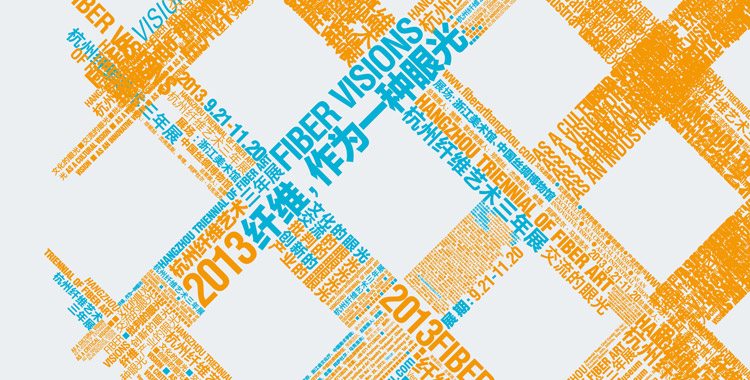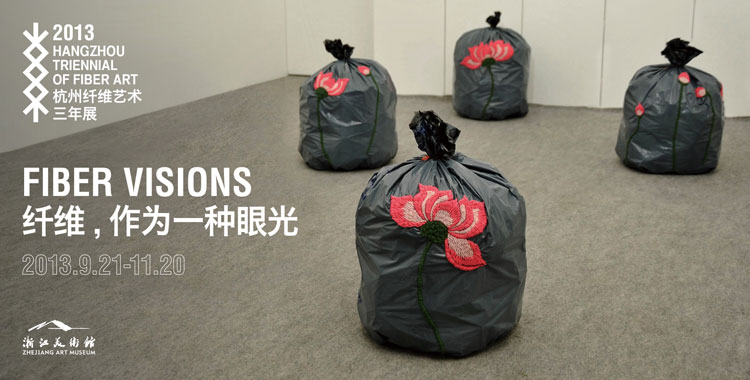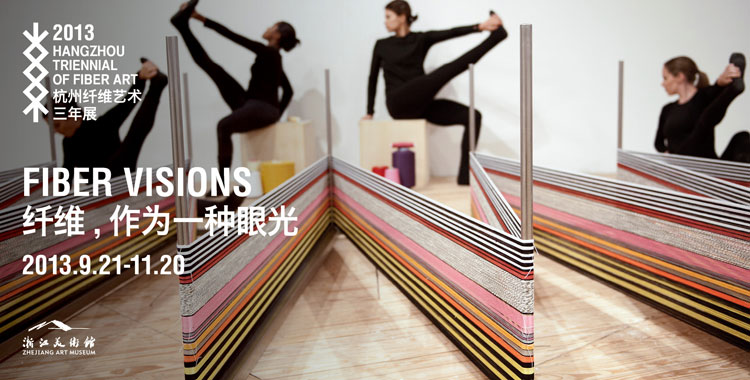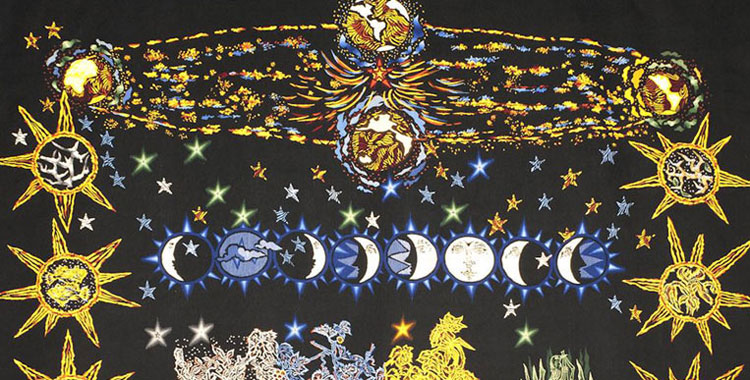Exposition of the themes
The first Hangzhou International Triennial of Fibre Art will have ‘Fibre Visions’ as its theme.
‘Fibre Visions’ will elaborate on ‘fibre’, an ancient, historical yet indispensable material with profound implications for our society, life and spiritual world.
As a cultural vision, Fibre exists not only in the category of art, but also in human culture. Fibre is inextricably linked to human civilisation as the earliest expression of written word. The words ‘text’ and ‘textile’ in English are both derived from the Latin word ‘textus’, meaning ‘weave’. Fibre accompanies humanity from their birth and comes into intimate contact with human skin, which then becomes transformed into a poetry that runs through human history. Fibre offers us security and materiality, yet we supply fibre with artistry and poetry. The embroidered portraits of the Buddha and Thang-ga in Chinese Buddhist art and the Biblical tapestry and embroideries produced in Middle-age Europe are all crystallised labour and wisdom of humanity. In the age of technology, artists may express and explore with the language of fibre not only a call to traditional culture and nature, but also a quest for natural harmony and at-one-ness so that we can regain the meaning of life that we seem to be losing.
As a vision of exchange, fibre brings different generations into a synchronic presence. When art entered the 20th century, fashions came and went in the blink of an eye. The same applied to fibre art. At the beginning of the new century, artists started to look back on a century’s development and respond to the impact of certain historical landmarks. Thus, fibre art was presented as a kind of synchronic presence of different generations. When fibre art from different generations, cultures and communities encounter one another, they may pay homage to the past in memoriam, or they may reflect on and critique the present; they may explore in the possibilities of the future, or perhaps attempt at the interweaving of different times, locations and cultures. Fibre art can evoke passionate reflections on people’s own sense of cultural belonging with its multiple synchronic presences.
As a critical vision, fibre is never short of contemporaneity and experimentalism. In an age of unprecedented materialism, consumerism has also reached an unparalleled level. Demand for consumer products cover both everyday necessities and luxury goods, which has lent consumer products themselves double significance. Increasingly they are both necessities and luxury goods at once, due to the intervention of design and pursuit of higher quality of life. Fibre and textiles directly and accurately express the contemporary narrative as the dual-identity consumer goods. Textiles have been and are at the cutting edge of globalisation and new technology but at the same time. The resilient surface and tactile texture of fibre constitute the everyday language of fibre art. We constantly see food sewn with cloth, clothes woven with tape, a stay-at-home girl’s apartment made with disposable napkin and shopping trolleys interlaced with colourful threads. The most familiar objects in everyday life give a feeling of familiarity and strangeness at once, when clothed in fibre. So we stop to look at these uncanny ordinary objects and wonder whether the consumerist activities we consider as given are actually as glamorous as their surfaces suggest.
As an innovative vision, fibre art is weaving up a new world on a brand new ‘loom’ and performing the mix of a virtual space. The Nobel laureate Sir Charles Sherrington once compared man’s brain to an enchanted loom, ‘swiftly the head mass becomes an enchanted loom where millions of flashing shuttles weave a dissolving pattern…’(Man on His Nature, 1942) The linear nature of fibre art projects the linearity of the virtual world. On the Internet, people cannot see each other, yet they remain connected to one another through unseen cables. We can do virtually everything without going out, which was unthinkable in the pre-computer age. Yet we are already so used to this pattern. The exchange between man and object has thus changed, and so has that between men. Since the launch of Windows95, people have started to chat online. In the Internet space, text and voice interact with each other to form a new mode of dialogue on the computer screen. We have discovered that words familiar to the vocabulary of the textile industry such as ‘weave’, ‘net’, ‘loop’ and ‘network’ have entered the category of the Internet and taken part in the contact with the world that feeds back to our world. Weaving is changing our world without us knowing, and it will eventually become a digital reality, and perhaps become a new matter that connects to one another and plays an actively role in unprecedented form and design.
As an industrial vision, fibre art has a very deep cultural and popular heritage in Hangzhou, the ‘Prefecture of Silk’. The silk and tapestry satin produced in Hangzhou embody the consummate harmony and exquisiteness, for which they are dubbed ‘the flower of Oriental art’. They are not merely consumables for daily life; rather they carry the exuberance and artistic reflections of the people of Hangzhou, who seem to be born with the personality and all the complexes of fibre. The tender willows by Duanqiao, the Osman thus rain of Manjue Long, the heart-rending story of the Butterfly Lovers, and the touching legend of Madame White Snake, are all shrouded in a soft hue. The martyrdoms of Qiu Jin (1875 – 1907), Yue Fei (1103 – 1142) and Yu Qian (1398 – 1457) tell of a resilient quality. Fibre is also characterised by such soft resilience. Today, Hangzhou has grown into one of the most developed textile industry centres. With many years’ hard work, the Sijiqing Clothing Street has become the first street in the industry in China. To meet the challenges posed by globalised competition under new circumstances, China National Textile & Apparel Council and Hangzhou City Government have established here at the Sijiqing Clothing Street the Information and Commercial Centre for Textile and Clothing Industries of China (ICCTCC). In 2008, the ICCTCC launched the first multiplex space devoted to the service of textile and apparel industries in the nation, the ‘116 Fashion Design Creative Industry Park’, making it the best platform for the transformation from traditional cotton textile industry to creative cultural industries. The International Triennial of Fibre Art at Hangzhou will yet again steer the innovations in the textile and apparel industries and bring about rising living standards and innovations in the living space. We believe that the Fibre Art Triennial will help stimulate the economic development of Hangzhou and by extension the entire Yangtze River Delta, and push forward the upgrade of textile, tourism and creative industries.
Themed Exhibition
The themed exhibition will be arranged in four parts;
‘World of Weaving’,
‘Hand and Heart’,
‘Action and Negation’,
‘Soft and Solid’,
Consider meanings and communication, spatiality respectively focussed on the traditional art of weaving as the origin of fibre art, the craftsman-thinker whose technique match their vision, the artistic creator with a sharp acumen and the art constructor concerned about the environment, which are woven into the chain of themes for this exhibition.
‘World of Weaving’
The art of weaving across the world could be dated back to the beginning of human history. The history of fibre art is also one of different nationalities. In this section, textile art mainly from ancient China will be exhibited with traditional art of weaving from Asia, Africa, Europe and America. Audiences will be able to see the passing and spreading of the traditional techniques worldwide.
‘Hand and Heart’
The story of Paoding dissecting an ox in Zhuangzi tells of the complete mastery of a technique. As Zhuangzi advocates the aesthetic idea of techniques completely matching the craftsman’s vision, in contemporary fibre art, we can similarly identify works of great technical mastery. These works dig deep into the meaning of weaving, transforming technique into the lyric of creation. This part will also exhibit the collection of the Lausanne International Biennale of Tapestry.
‘Action and Negation’
The movement of the Dao is dialectical and forms a cycle. The dialectical impact is the driving force behind the changes in the world, which suggest that a critical spirit is an innovative force in moving forward the historical progress. On the other hand, what has been ‘negated’ is not negated for the sake of it. Rather it is a return to the origin of things. This part will house works that reflect urban development and engage in a critical examination of the urban relationship between man and object, and of the modern phenomenon of consumerism.
‘Soft and Solid’
The softness of fibre art will become the new arena of public art creation.
We can detect in the warm, large and light volume of fibre and textile works the great advantage and potential of fibre art in a solid, shared space constructed with steel and glass, which points us to the direction of redefining public art and space.
There is the opportunity for new performance based work, the new generation of artists that work on site and cultural encounters that communicate across national boundaries.
Feb. 7th, 2012


























